new posts in all blogs
Viewing: Blog Posts Tagged with: Models Posing, Most Recent at Top [Help]
Results 1 - 25 of 35
How to use this Page
You are viewing the most recent posts tagged with the words: Models Posing in the JacketFlap blog reader. What is a tag? Think of a tag as a keyword or category label. Tags can both help you find posts on JacketFlap.com as well as provide an easy way for you to "remember" and classify posts for later recall. Try adding a tag yourself by clicking "Add a tag" below a post's header. Scroll down through the list of Recent Posts in the left column and click on a post title that sounds interesting. You can view all posts from a specific blog by clicking the Blog name in the right column, or you can click a 'More Posts from this Blog' link in any individual post.
 |
| James Warhola posing for an Etruscan musician |
Here's a tip when you need a quick prop for your model to interact with, but you don't have time to build an elaborate replica. Just draw the shape of it on the surface of a piece of cardboard and cut out what you need. At least that gives the model something three dimensional to hold, and you don't have to make up the whole thing.
It works for a lot of things—instruments, guns, shields, furniture, windows. It only takes a couple of minutes to build, and it's recyclable when you're done.
The full illustration appears in the June, 1988 issue of National Geographic, in the story "The Eternal Etruscans" or on the
History and Science section of my website.
It also appears in my book
Imaginative Realism: How to Paint What Doesn't Exist

At our figure sketch group we want to paint a person doing a real action, rather than holding an artificial pose.
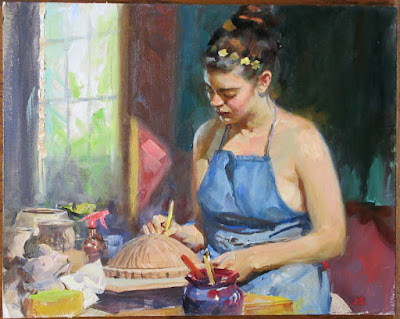 |
| Sarah the Potter, oil on canvas, 9x12 inches, 5 hours |
So we ask Sarah to bring her pottery supplies and to do her normal work.
We agree on a base pose that she can return to from time to time. We talk to her during the pose, so she's not holding totally still.
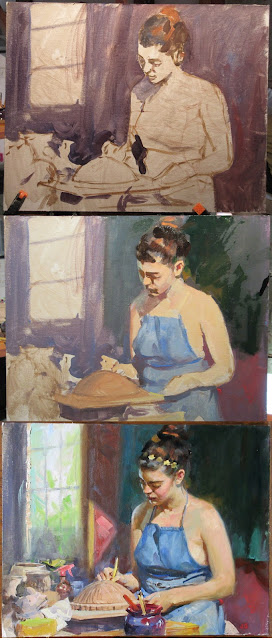
1. I draw with the brush on gesso-primed canvas mounted on a Masonite panel. I begin the quick block-in with casein. Casein is a good underpainting medium.
Right away I'm looking for the big shapes of tone, in this case her light face and figure against the simple dark background.
2. I begin to overpaint with oil on the face, hair, and background. Eventually, about 95 percent of the surface will be covered with oil paint. The oil paint achieves deeper values than the casein because of its glossiness.
I have three cups: Gamsol for thinner, Liquin, and a slow-drying medium (equal parts stand oil, damar varnish, and turpentine).
3. I simplify the tones in the arm and shoulder and torso, painting them with very little value variation and using color temperature to turn the form instead.
Consequently, the front plane of her shoulder has a slightly cooler cast.
Her hair melts into the simple tones of the background. On the left, I paint the window mullions and other background details out of focus.
In contrast to those empty shapes, I revel in the sharp accents and clutter of the worktable.

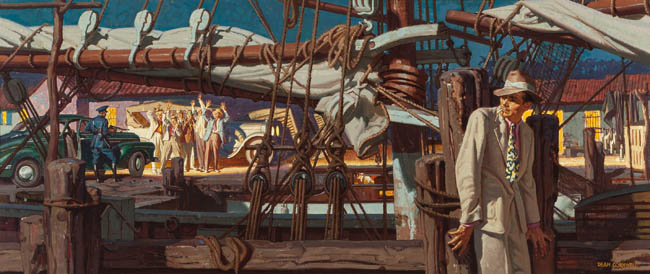 |
| Dean Cornwell, Saturday Evening Post, 1947, "Night Boat from Havana" 21x58 in. |
At their upcoming May 2 sale of American Art,
Heritage Auctions is offering an illustration by Dean Cornwell (1892-1960).
A car's headlights shine on a group of captured Cuban gangsters at the waterfront. Cornwell "saved $50 in models' fees" by having a group of his illustrator friends—some of the top talent in the business—pose for him as the smugglers.
The models include: Frank Reilly, Arthur William Brown, Gilbert Bundy, Harry Beckhoff, and John Gannam. Cornwell took a photo as a convenience, though in his earlier days he would have worked from life. Cornwell said, "Life models are soft these days and don't like to hold a pose long." Plus, they had deadlines.
-----

Every Thursday night in Los Angeles, a group of artists gets together to draw from the model, but this is no ordinary sketch group.
Organized by
Art Center teacher Bob Kato, attendees of
the Drawing Club work from costumed models who are set up with props and set pieces to suggest a specific character. Themes include such classic types as "The Detective," "French Maid," "The Samurai," or "The Rock Star."
The Thursday night sessions are mostly short poses ranging from 5 minutes to a half hour, and they have long poses on Sundays.
For example, here's Steve Jacobsen modeling as The Chef.
And here's one of the drawings by visual development artist and character designer Brett Bean.
The Drawing Club is not a class; it's more of an open workshop. Anyone who pays the $20.00 entry fee can attend, and the regulars include a lot of master animators and character designers from Walt Disney Feature Animation or DreamWorks Animation who are looking to brush up on their drawing skills. There are also plenty of students, and a spirit of experimentation.
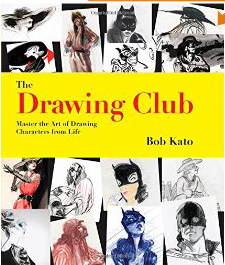
Bob Kato recently released a book of some of the work that has come out of the Drawing Club. The 9x9 inch softcover edition is 144 pages long, and is lavishly illustrated with examples from 66 different artists.
The text by Mr. Kato is full of encouraging tips for going beyond what you're actually observing from the live model. He suggests a variety of media: pencil, markers, brush-and-ink, watercolor, and digital.
Mr. Kato explains how each artist approaches the challenge differently depending on the kind of work they do.
"Story artists like models to do quick, daring poses because they're looking for gestural movement as it relates to storytelling. Their sense of design is heavily invested in the communication of the moment, rather than what media looks best....The character artists, on the other hand, are always looking at the model like a raw ingredient that will be turned into their own version of the character. When the model shows up in costume and starts posing, they look at the shapes made by the costume and character and get to work redesigning...to make the character funnier, scarier, happier, or sadder. They take the pieces apart—a gangster's hat, tie, overcoat, drooping cigarette, and gun—and create their own version."
Book:
The Drawing Club: Master the Art of Drawing Characters from Life
Website:
The Drawing Club

In 1996, Storyworks magazine sponsored a national poster contest inviting school kids to portray an answer to the question "If the residents of Dinotopia came to your hometown, how would you welcome them?"
I selected the six winning posters out of hundreds that were submitted. The grand prize winners, it turned out, came from all across the USA.
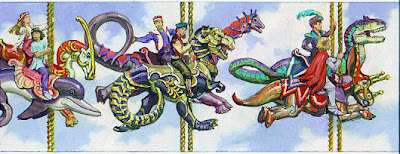
The prize for each of the six winners was not only a signed book, but a chance to pose for a new Dinotopia painting. My original idea was to show the six kids riding around in a dinosaur version of a merry-go-round or carousel, maybe flying through the air with a blue sky background. That's my concept sketch above.
From the beginning, I knew that the logistics of transporting each of the winners and their parents to my studio would be impossible, so I would have to take the risk of working from reference that they provided.
I asked them to find a parent or helper to set them up with a "Dinotopian" costume and to take a few dozen photos, facing to the right, and not looking at the camera. The photos were even better than I expected, and the costumes and expressions were really fun to work from.

It dawned on me, though, that it made more sense to show them on real dinosaurs instead of on a carousel. So I switched the concept when I did the final painting, a large oil panorama.
•
Read about the experience of Kathryn Noel of Utah, who appears on the left• Some of the reference photos, as well as the final painting will be part of the Lyman Allyn Art Museum exhibition
"Dinotopia: Art, Science, and Imagination" opening on September 22.
• More about the exhibition on the blogs
Lines and Colors and
Underpaintings• The art also appeared as an accordion-fold greeting card, but I'll show that in a future post.
Sometimes the photo reference is more entertaining than the final painting.
I'm posing as Arthur Denison. From
Dinotopia: Journey to Chandara. The book is still currently available at
Amazon
, but the publisher's warehouse is sold out, awaiting a reprint. We have
signed copies here at the Dinotopia Store.
When you need the right reference photo, you do what you gotta do.
----
From
Dinotopia: Journey to Chandara, 2007.
Previously on GurneyJourney:
New Use for Refrigerator Cartons
Sometimes it's fun to act out a scene, even if the photo reference that you get out of it isn't that useful directly.
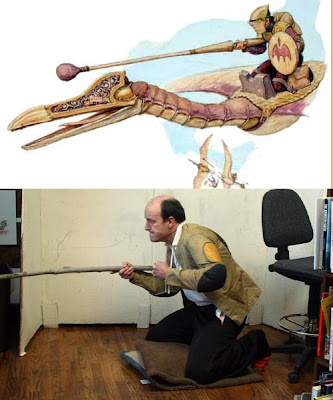
The idea is to get into the spirit of the action, feel the wind in your face and hear the screech of the pterosaur.
I think that's more important than getting a photographically real piece of reference to copy. If you can identify with the weight and balance of things, and especially the emotion, you've got 90% of the problem solved.
The painting of "Air Jousting" is from Dinotopia: Journey to Chandara.
Previous and related posts:
Air Jousting
My Preference for Reference
New Use for Refrigerator Cartons
Cincinnati-born Robert Frederick Blum (1857-1903) is perhaps best known for his paintings of Venice and Japan, but in his day he was also renowned as a muralist.
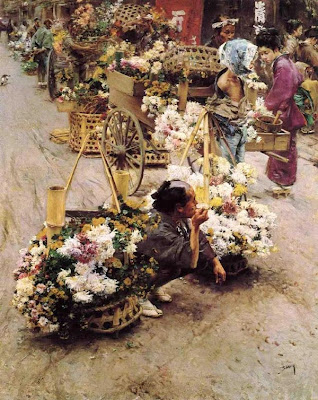
His most ambitious mural undertaking was the decoration of the Mendelssohn Music Hall, home of the Mendelssohn Glee Club, which was once located at 113-119 West 40th Street in New York.
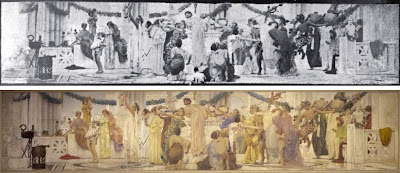
The first was called “Moods of Music,” started in 1893, and followed soon after by “Feast of Bacchus,” from 1895. The Bacchus subject is shown in two repros above: Note Blum in the top black and white image, photographed working on the mural at center.
Each frieze was 50 feet long and 12 feet high. The twin panels flanked the proscenium arch of the concert hall.
Blum executed the murals on canvas in a studio that was too small to unroll the composition to its full extent. He opened it one third at a time, but wasn’t able to see it all together until it was installed.
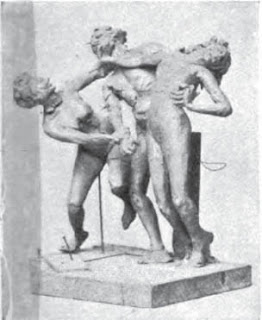 He developed the composition for “Feast of Bacchus” over a period of three months by sculpting groups of small figures in clay and setting them on a ledge, rearranging them as a tableau until he was satisfied with the relationships of the figures. According to an observer at the time, by using this method, “he could study each figure in the round instead of in the flat, could block out the perspective, could tell which knot of figures to make prominent and which subordinate, and, in brief, handle a plastic theme in a plastic manner.”
He developed the composition for “Feast of Bacchus” over a period of three months by sculpting groups of small figures in clay and setting them on a ledge, rearranging them as a tableau until he was satisfied with the relationships of the figures. According to an observer at the time, by using this method, “he could study each figure in the round instead of in the flat, could block out the perspective, could tell which knot of figures to make prominent and which subordinate, and, in brief, handle a plastic theme in a plastic manner.”
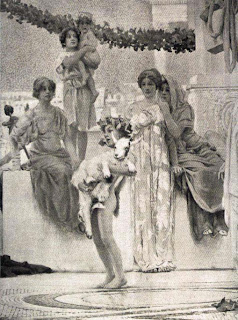
After sculpting the maquettes, he sketched the design in color, posed models for each of the figures, and made individual studies of the costumes and decorative details.
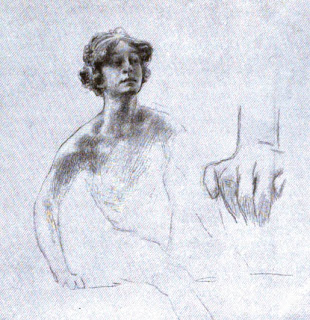
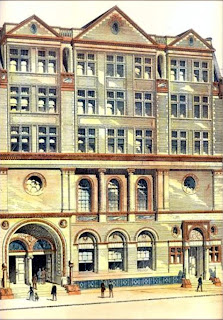
Herbert James Draper (1863-1920) was another one of those lesser-known Victorian painters who combined good drawing with a romantic sensibility in his painting of mythological subjects.

He based the painting “Flying Fish” on a charcoal study from a live model. The figure’s pose, with the foreshortened near arm, is delightful. He keeps his tonal masses simple. The light mass is kept light throughout, allowing much of the upper figure to read very delicately as light-against-light.
Images from the “Inspirational Works of Art” archive (which contains some artistic nudity). Thanks, Keita!
If you like Draper, you’ll like Waterhouse, Leighton, Tadema, Solomon, and Dicksee.
And there's a 2003 book on Herbert Draper.
When you set out to do a painting of a scene from fantasy or history, you have a range of choices for reference.
There’s an argument for using no reference at all. If you train your memory, you can work entirely from your imagination, which helps particularly in the development stages of the idea.
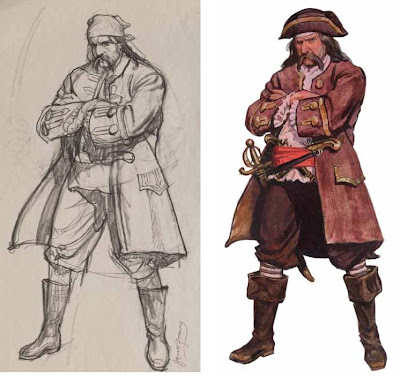
And there are pros and cons of using traditional drawn studies of a model. Above is a charcoal mirror study of me posing in a pirate costume and the resulting painting.
There are also benefits of working from photo reference, especially when you’re dealing with kids, animals, or anything in movement. When I needed to paint a picture of a kid playing tug-of-war with a dinosaur, the first drawing I did from my head didn’t have the conviction that came later when I actually staged and photographed the action.

Photography has its benefits, but also its pitfalls. Copying a photo too much can drain the mythic magic from your painting. Photographic effects such as depth of field and motion blur belong in some images, but not in others.
Everyone has to develop a reference strategy that suits their goals. I’m a pragmatist on this issue: the desired results govern the choices, and I’ve used every kind of reference.

This meaty topic is the subject of a six page workshop that I wrote for the June, 2011 issue of ImagineFX magazine. You can pick up a copy at the local newsstand, or visit their website. The accompanying DVD has a couple of my short videos and lots of examples.
ImagineFX magazine
This topic is also explored in Imaginative Realism: How to Paint What Doesn’t Exist.
Tug-of-war image from Dinotopia: Journey to Chandara
Pirate image is from Dinotopia Lost by Alan Dean Foster
Previous posts on GurneyJourney
Acting it Out: (Tug of War)
Rackham on Photo Reference
Using Photo Reference (32 comments)
In case you need to draw somebody falling off a horse or flying through the air, you can suspend them from large metal rings hanging from a roof beam in your studio.
Cool idea. Can’t say I’ve tried that yet.
-------
From "Artists' Models in New York," by Charlotte Adams,
The Century Illustrated Monthly Magazine, Volume 25, page 569.
Previously on GJ:
Painful Poses
Sometimes I think it’s helpful to use several different reference sources for a given figure. For this science fiction cover called Space Jockey (Color and Light, page 163), I wanted to show a space pilot who seemed to come from the “Right Stuff” era of bold space exploration.
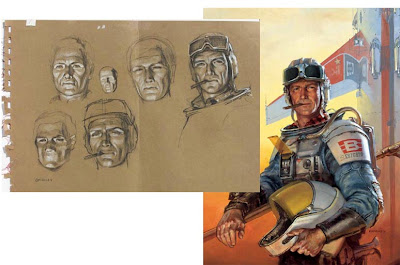
Instead of resorting to the camera to take photos of a specific model, I tried to construct the character in my imagination by using a variety of charcoal studies on tone paper. Some are done from my own face in a mirror, lit frontally with a clip-on lamp. I also used a couple of my little plaster head maquettes as models. The one in the lower left is the simplified plane head (Imaginative Realism, page 69, based on George Bridgman’s analysis) with a “mouth barrel.”
In the end I only used photo reference indirectly for some of the costume details, but not for the face and hands. This way of working helps steer me to a more structural understanding, away from a purely photographic look.
----------
Color and Light on Amazon
Imaginative Realism on Amazon
Or get them signed at the Dinotopia Store
Previous Posts: Character Maquettes,
Tone paper studies, Using (or not using) Photo Reference
Artists’ models often had to endure difficult poses in the Royal Academy.

“The pose is occasionally very painful to retain for any length of time, especially when the head is turned or the arms uplifted,” said M.H. Spielmann, a contemporary observer. Models that moved the least bit ruined their reputation as a sitter.

A model’s uplifted arm was often suspended by ropes or chains. The dying horseman for the painting “Last Call” by the sculptor Charles Bell Birch (1832-1893) held onto a bar attached to the rafters, while his “horse” was raised up on pulleys.
----
Second image (and Birch bio) at
Tiscali.co.ukM.H. Spielmann in
Magazine of Art, 1888, page 139.
When the Norman Rockwell Museum in Massachusetts hosted a Dinotopia exhibition in 2006, a small group of Dinotopia fans from all over the world assembled at a mini-convention called “The Stockbridge Stomp.”

I joined them for the festivities and then invited them to my studio a short drive away, so that they could pose for a painting I was working on.

We had a big bowl of homemade soup together, and then they put on costumes, some of which they brought with them. They posed in small groups, imagining themselves standing beside a Styracosaurus and a Chasmosaurus. Many of the figures in the painting were based on that impromptu gathering.
The painting appeared on the title page of Dinotopia Journey to Chandara. The painting also appears in Color and Light, page 116.
This painting will be one of about 40 paintings from Dinotopia Journey to Chandara, opening today at the The Alden B. Dow Museum of Science and Art in, Midland, Michigan.
----------
The Alden B. Dow Museum of Science and Art/ Midland Center for the Arts
Web article about the exhibit, which includes “Bigger than T. Rex: Giant Killer Dinosaurs of Argentina.”
Journey to Chandara at the Dinotopia Store.
Journey to Chandara on Amazon.
Thanks to all the Stompers!
 British painter of myth and romance, John William Waterhouse, (1849-1917) did these lovely studies from the model as reference for his painting Hylas and the Nymphs.
British painter of myth and romance, John William Waterhouse, (1849-1917) did these lovely studies from the model as reference for his painting Hylas and the Nymphs.
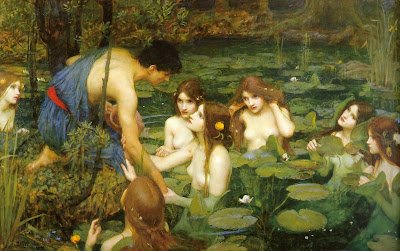 The finished painting shows the story from Jason and the Argonauts, where Hylas, fetching water for Heracles, comes upon a spring inhabited by alluring nymphs, who beckon him to his watery death.
The finished painting shows the story from Jason and the Argonauts, where Hylas, fetching water for Heracles, comes upon a spring inhabited by alluring nymphs, who beckon him to his watery death.
Wikipedia: Hylas
Wikipedia Waterhouse
Many more examples of Waterhouse's paintings at Art Renewal Center
Lovell used photo reference when he had to, as with this photo of a member of the 173rd Army Airborne Brigade in Vietnam, for his painting “The Chaplain in Southeast Asia.”
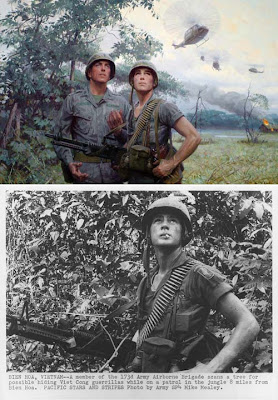 The connection between the photo reference and the painting was made by blog reader Gene Snyder, who noticed the resemblance while photographing over 9,000 art images in the Army's art collection over the course of several years.
The connection between the photo reference and the painting was made by blog reader Gene Snyder, who noticed the resemblance while photographing over 9,000 art images in the Army's art collection over the course of several years.
But Lovell also used other, more traditional means of getting figure and animal reference. He preferred to work from drawings made from posed models in the old master tradition. He also frequently did mirror studies, posing himself in a mirror to take the action of the pose.

 Lovell also made maquettes of animals and ships, which can be difficult to visualize otherwise.
Lovell also made maquettes of animals and ships, which can be difficult to visualize otherwise.
The study of the clay model was made in charcoal and pastel 11x14 on Kraft paper.
The painting is called Camels in Texas, 1971, commissioned by the Petroleum Museum in Midlands Texas.
-------
Thanks, Joe and Gene S.
Previous Post: Lovell's Soldier (where he uses mirror drawings)
Michelle LaNasa, a student teacher in northeastern Ohio, has been using the methods described in Imaginative Realism as a textbook in her art classes.
She writes:
“I was inspired by your method of photographing friends and neighbors to create characters, and I passed around copies of Dinotopia and Imaginative Realism. We focused on creating a character through body language, being observant of fabric folds, and using pastels.
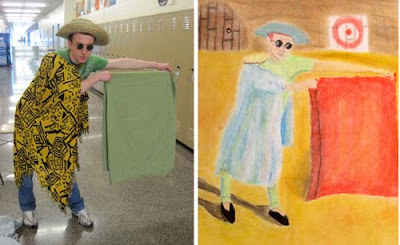 Above: “S's Time-Jumping Matador”
Above: “S's Time-Jumping Matador”
“I brought costumes to school and had each student dress up. They assumed the body language of a character that they had made up, and I photographed them. There were dancers and spies, kings and assassins, and even a deranged scientist intent on stealing breakfast cereal.
 Above: “Z’s Aqua Girloo”
Above: “Z’s Aqua Girloo”
“I printed their photos so the students could use themselves as a reference. They lightly sketched out the drawing, adding imaginative details to further define their character, then fleshed it out with pastels. At the end, they wrote brief background stories of who they had drawn, what they were doing, and how they had gotten into their (sometimes wonderfully strange) situations.”
If you’re a teacher, and you’ve been using Imaginative Realism in your school class, send me photos and a description of your project, and I’ll try to post about it. You can reach me at [email protected].
Arthur Rackham, the story goes, hired an old woman model who posed for many of his characters: not just nymphs and hags, but also trees and dragons.
Whenever you’re creating an imaginary creature, it’s good to have someone act out the pose. In a pinch you can act it out yourself in front of a mirror or a camera with a self-timer. You can change all the forms around, but there are often valuable details you can pick up from real life.

This little hunchback monster, a sidekick to the Birdman character (full image on earlier GJ post) was such a reality-based creature.
 Even though I made a little maquette, I based details of his forehead and his hands on the live-action photograph, which I made with a digital camera on a timer.
Even though I made a little maquette, I based details of his forehead and his hands on the live-action photograph, which I made with a digital camera on a timer.
The original painting is currently on display at the "Son of Baby Tattooville" exhibition at Riverside Art Museum in southern California. The show will end November 21.
Earlier GJ post on the exhibition.
Norman Rockwell went to great lengths to get his models to act. He spared no expense in hiring photographers to document their performances. The resulting photos—20,000 of which are in the Norman Rockwell Museum’s archives and have just been digitized—served as references for most of his famous Post covers after the mid-1930s.

As a new book and an upcoming exhibition demonstrates, Rockwell was always conscious of going well beyond the photo, striving for a exaggerated reality to communicate his ideas.
His painting “The Gossips,” 1948 (Oil on canvas, 33” x 31”) is a good example. The 30 heads in the painting pass along a piece of gossip about Mr. Rockwell himself, who confronts the source of the rumor in the last pairing.
 The old lady and the young woman with the scarf went through a big transformation from photo to painting. The older woman in the painting is seen more in profile; and her smile is broadened. The younger woman’s eyes and her mouth open wider and her head tilts more forward.
The old lady and the young woman with the scarf went through a big transformation from photo to painting. The older woman in the painting is seen more in profile; and her smile is broadened. The younger woman’s eyes and her mouth open wider and her head tilts more forward.
 The man in this pairing gets a bigger shock of hair, a pointier nose, and a more wide-open mouth. His neck protrudes from a greatly simplified collar. The woman is brought more into profile, and she’s given a hand.
The man in this pairing gets a bigger shock of hair, a pointier nose, and a more wide-open mouth. His neck protrudes from a greatly simplified collar. The woman is brought more into profile, and she’s given a hand.
 The man at left loses his hat, probably to avoid duplicating his counterpart. All his expressive features: eyes, eyebrows, and mouth are exaggerated—and he gets a hand with a cigar. The man at right, who appears just before the crescendo of the story, is pushed to the extreme. His chin tucks in, his hat tips to the side, he’s gets a bow tie, and his head takes the shape of a light bulb.
The man at left loses his hat, probably to avoid duplicating his counterpart. All his expressive features: eyes, eyebrows, and mouth are exaggerated—and he gets a hand with a cigar. The man at right, who appears just before the crescendo of the story, is pushed to the extreme. His chin tucks in, his hat tips to the side, he’s gets a bow tie, and his head takes the shape of a light bulb.
Rockwell also lifts his eyebrows. Hardly any model—except maybe Jim Carrey--can simultaneously drop the jaw, squint the eyes, and lift the eyebrows. It’s not easy; try it! But it looks right, and Rockwell got it in the final.
Rockwell always wrestled with his conscience over his use of the camera and the projector, which he called “an evil, inartistic, habit-forming, lazy, and vicious machine.”
But he should have been easier on himself, because he really set a good example to the rest of us about how to use photos intelligently. He rarely forgot his initial conception, and he only used the photos as a starting point.
As he said in his classic work “Rockwell on Rockwell,” 1949, “I feel that the characters which I produce in this way more nearly express those which I have in my mind and which I am trying to portray.”
------
More about new book Norman Rockwell Behind the Camera, by Ron Schick on Amazon.
The exhibition: Norman Rockwell Behind the Camera will run at the Norman Rockwell Museum from November 7 – May 31, 2010, link for more info.
There’s an article in this month’s Vanity Fair with lots of images and a surprisingly respectful biographical overview.
My next job was to die a thousand deaths.
I had to act out the parts of all the sailors in various conditions of
leaping, swimming, nursing injuries, or manning oars. Wearing a navy uniform that I found in a surplus store, I jumped off a platform and writhed around on the ground, trying to imagine what it would have been like for the various sailors who were coping with the tragedy.
 My wife took snapshots with a digital camera. One of the photos has a motion blur effect that I used in the final painting. There were something like 90 figures in all, and I wanted to make each one a little actor facing his own terrible drama.
My wife took snapshots with a digital camera. One of the photos has a motion blur effect that I used in the final painting. There were something like 90 figures in all, and I wanted to make each one a little actor facing his own terrible drama.
 One of the most helpful parts of the research was a visit with a naval historian named Colan Ratliff at the Naval Surface Warfare Center in Bethesda, Maryland. This was an awesome place to visit, but I couldn't take pictures because it's a classified research facility.
One of the most helpful parts of the research was a visit with a naval historian named Colan Ratliff at the Naval Surface Warfare Center in Bethesda, Maryland. This was an awesome place to visit, but I couldn't take pictures because it's a classified research facility.
Mr. Ratliff, who works deep in the heart of the complex, has built several museum models and drawn extensive plans of the vessels involved in this battle.
 From our consultations, and from the approved concept sketch, I made a comprehensive line drawing and sent copies to Mr. Ratliff. His notes, drawn on a sticky note over the photocopied drawing, corrected some of my errors.
From our consultations, and from the approved concept sketch, I made a comprehensive line drawing and sent copies to Mr. Ratliff. His notes, drawn on a sticky note over the photocopied drawing, corrected some of my errors.
I had shown the old-fashioned deadeyes instead of rigging screws and had drawn the wrong kind of gooseneck attaching the boom to the mast. These corrections were going on by phone, mail and email for months after our meeting.
It really helps when a scientific or historical consultant can draw to explain their points, and many of them can.
With all the references and corrections in place, and after nearly a year of
research and roughs, I finally was ready to start the 30 x 40-inch oil painting, which took a couple of months. Most of the time was devoted to painting the various figures.
As I worked, I did everything I could to project myself into the action of the scene: playing the soundtrack to Master and Commander, the Flying Dutchman overture, and Rimsky Korsakov——and reading again and again the eyewitness accounts.
Warfare was such a brutal face-to-face thing in the Civil War. The guys on the Virginia could hear the screams of the Cumberland's wounded men below decks as they drowned.
Continuing yesterday's costume tips:

7. You can improvise a lot of costume details with samples of fabric combined with old clothes from your closet. It doesn’t matter if the color matches or if it looks good enough to go on stage. You’re just looking for information about folds and drapery.
8. If you can’t fine the right costume, don’t worry! Remnants of leather, satin, brocade, or velvet from a fabric store can provide you with helpful information about the behavior of the fabric. Steel bowls from the kitchen can give ideas for how armor would look.
9. For simple togas and capes, you can drape and pin fabric samples over your artist mannikin or dressmaker’s dummy. For the fabric to scale down to a miniature size, it should be a very light weight. Cellophane scales down really well over a miniature figure, and can be spray painted to give it opacity (Thanks, Graydon).
10. Don’t be shy to ask for help. If you know someone who is clever with a sewing machine and can think laterally, they might be able to help you improvise a few basic things.
11. Once you get your model (or yourself) in costume, you can take reference photos in a variety of poses. If it’s an easy pose to hold, you can work directly from the model.
12. If you attend a sketch group, ask if your fellow artists might enjoy sketching from a costumed model. If so, everyone can pitch in a costume or two, or the models may come with something. You can usually pay the model to stay after the sketch session to work with you for reference.
An artist like Edwin Austin Abbey (below: "Who is Sylvia") was legendary among his peers for lavishing a fortune on the right costume for reference. (More Abbey samples here)
 Good costumes can be expensive to buy or rent. And they can be difficult to make. But having a real costume makes a huge difference in your finished work. You can tell right away if an artist just made up a costume or went to the trouble to get a real one.
Good costumes can be expensive to buy or rent. And they can be difficult to make. But having a real costume makes a huge difference in your finished work. You can tell right away if an artist just made up a costume or went to the trouble to get a real one.
Abbey’s illustrations commanded princely sums a hundred years ago. What are we mortals to do nowadays on a shoestring budget? Today and tomorrow I'll offer 12 tips to save you money, time, and trouble.

1. You can find costumes at thrift stores or junk shops. Almost every garage sale has a Halloween costume or an unusual hat that you may want to use later.
2. Many smaller communites have a local theater company with costume collections. They are sometimes willing to loan their costumes to illustrators.
3. Renaissance festivals have vendors with an assortment of hats, cloaks, corsets, gowns, breeches, and doublets. Example: Moresca Clothing and Costume. That’s where the blue and red jacket came from, and I’ve used it in many Dinotopia pictures.
4. People who work in living history museums wear very authentic costumes. I've found they're glad to model for a sketchbook study. They may also be willing to pose for photo reference, but be sure to get their written permission first. Examples: Plimouth Plantation, Old Sturbridge Village, Colonial Williamsburg.
5. Big cities like New York, London, or Los Angeles have rental agencies serving theatrical or movie productions. Sometimes they will sell off their older, worn-out costumes. That’s where the doublet with the slashed sleeves above came from. Examples: Palace Costumes, Adele's Costumes.
6. Large museums, like the Metropolitan Museum or the Victoria and Albert in London have costume collections which can usually be sketched or photographed. Examples: Metropolitan Museum Costume Institute, Victoria and Albert Museum, London.
Tomorrow: Six more costume tips.
View Next 9 Posts





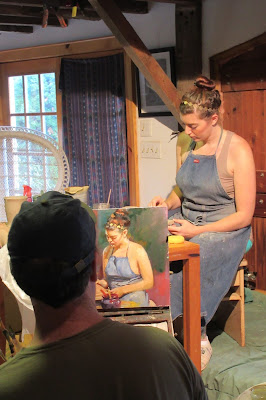
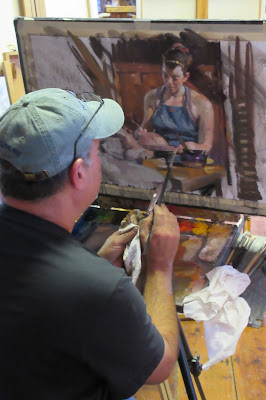
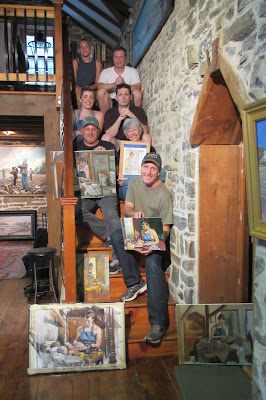

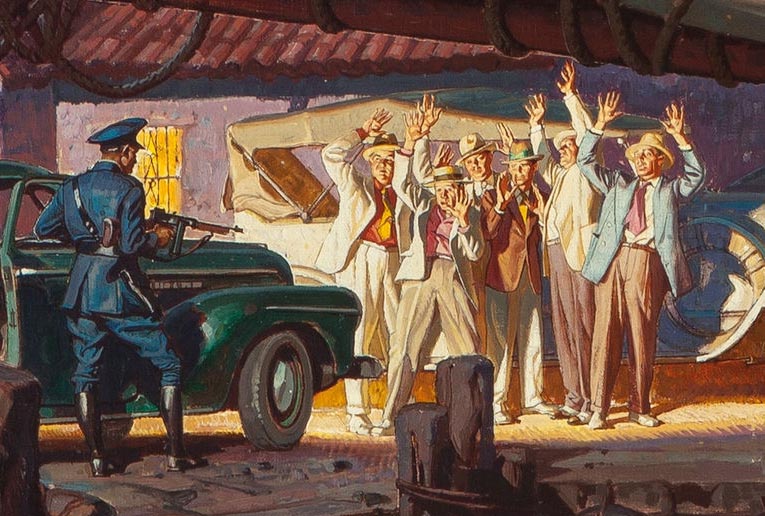
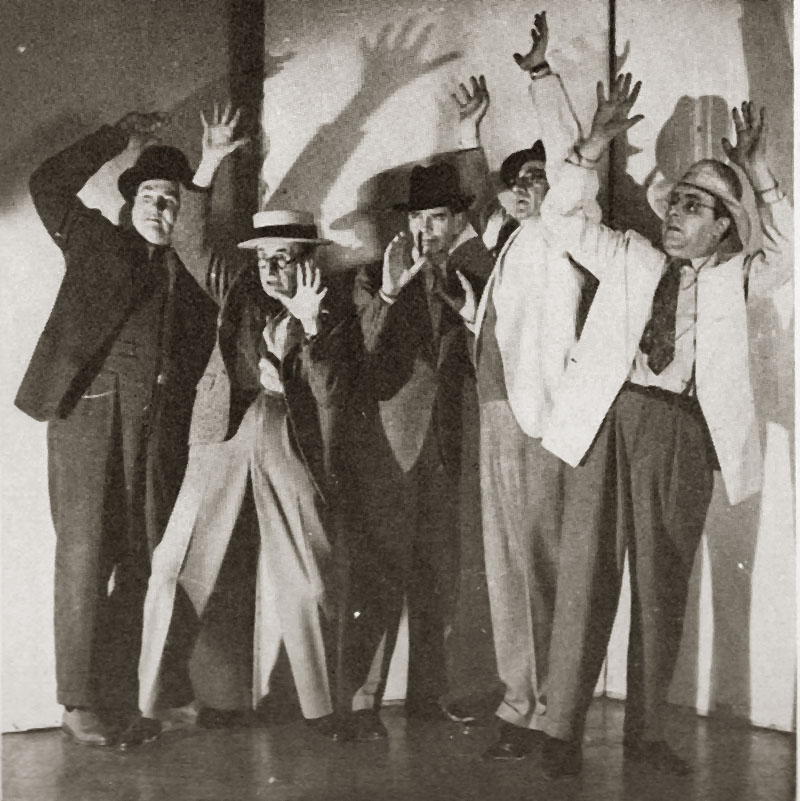

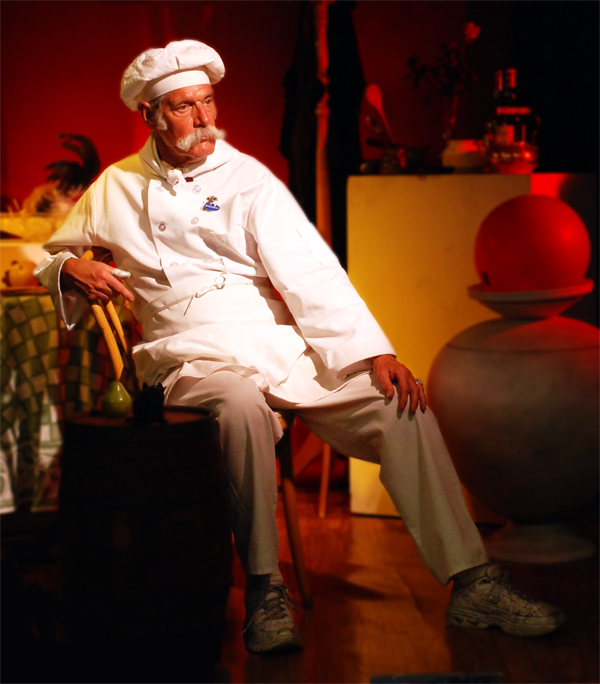
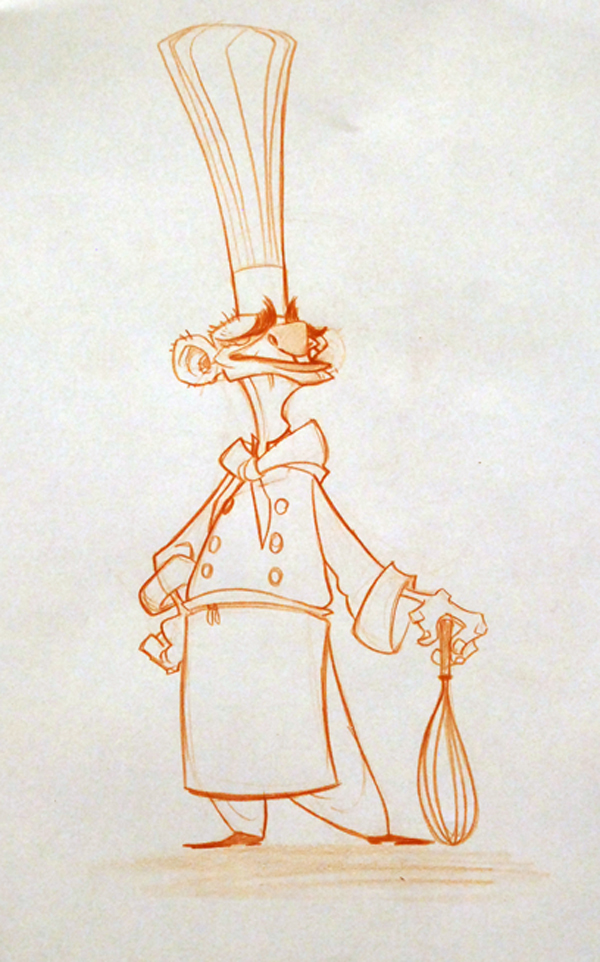

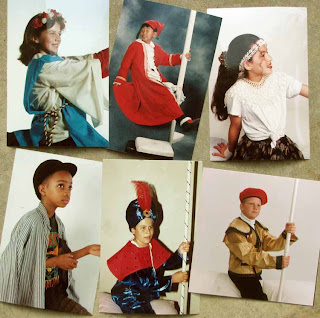


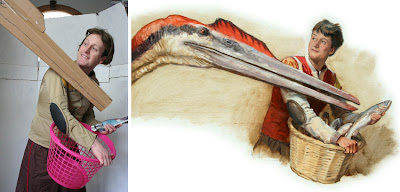

























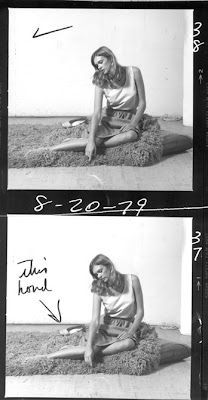












Fantastic! And so creative. This is something those kids will remember all of their lives!
It's so great to see how you work with (i.e. transform) the reference photos. It took me a litle while to find the African American boy, until I realized you'd put him in a new costume with turban, and changed his head angle somewhat.
Really wonderful idea, and of course an excellent execution of it!
What a ride!
Some how I really think the carousel layout appeals to me more because of the dream and fantasy feeling but the other layout has a more natural and casual look. Both are interesting and pleasant to look at.
I've always liked the somber expression on the horn player. Now I see that it wasn't really planned.
Which usually definitely the best web site,these worth will be able to preserve that , thanks a lot unquestionably the bloger£¬I believe that you are going to unique during Michael Kors Outlet Online
Michael Kors Grayson Satchel. welcome to our own website : http://www.michaelkors2outlets.com.